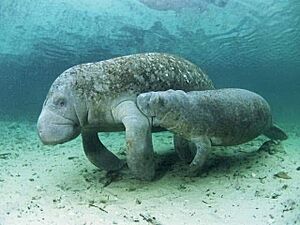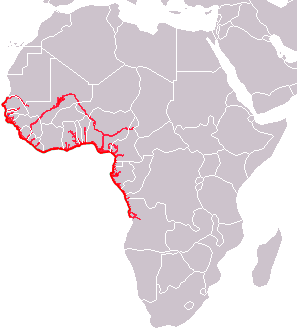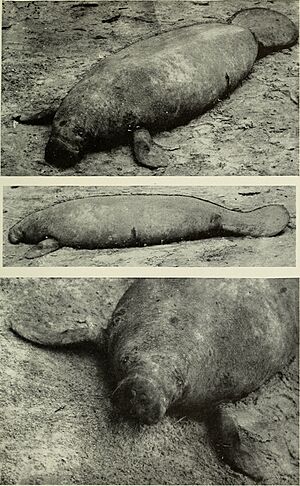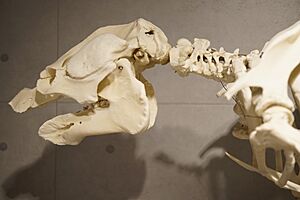African manatee facts for kids
Quick facts for kids African manatee |
|
|---|---|
 |
|
| African manatee in Nigeria | |
| Conservation status | |
| Scientific classification | |
 |
|
| African manatee range |
The African manatee (Trichechus senegalensis), also called the West African manatee, is a type of manatee. It lives in many parts of western Africa, from Senegal all the way to Angola. It is the only manatee species found in the Old World (Africa, Asia, and Europe).
Contents
What is the African Manatee?
The African manatee was first officially named Trichechus senegalensis in 1795 by a scientist named Johann Heinrich Friedrich Link. There are no known different types (subspecies) of this manatee. Even though some African manatees live near the coast and others live far inland, their genes are very similar. The African manatee belongs to the same group, Trichechus, as two other species: the Amazonian manatee and the West Indian manatee. All manatees are part of a group of marine mammals called sirenians.
Where Do African Manatees Live?
African manatees live in more different kinds of places than any other sirenian. You can find them near islands in the Atlantic Ocean, in rivers in the western Sahel region, and in rivers within rainforests. Manatees living near the coast often swim up rivers when it's rainy. They then go back to the coast during the dry season.
However, large dams built for farming and electricity, like the Akosombo Dam in Ghana, can block their paths. This traps groups of manatees and keeps them from moving freely. For example, the Diama Dam and Felou Dam in Mali have permanently separated manatees in the Senegal River from the coast.
African manatees can be found in many West African countries. These include Angola, Benin, Cameroon, Chad, Congo, DR Congo, Côte d'Ivoire, Equatorial Guinea, Gabon, The Gambia, Ghana, Guinea, Guinea-Bissau, Liberia, Mali, Mauritania, Niger, Nigeria, Senegal, Sierra Leone, and Togo.
They live in both salty (brackish) and fresh water. This means they can be found in oceans, rivers, lakes, coastal areas where rivers meet the sea (estuaries), and lagoons. African manatees usually avoid water colder than 18°C (64°F).
Manatees have been seen as far as 75 kilometers (47 miles) offshore. Here, they prefer shallow coastal areas and calm mangrove creeks filled with seagrass. Some inland lakes where they live include Lake Volta and the Inner Niger Delta in Mali. These lakes act as safe places for manatees during the dry season when river levels drop.
The areas with the most manatees include Guinea-Bissau, the lagoons of Côte d'Ivoire, and the southern parts of the Niger River in Nigeria. They are also common in the Sanaga River in Cameroon, coastal lagoons in Gabon, and the lower parts of the Congo River.
Scientists have tracked African manatees in Côte d'Ivoire. They found that most of them prefer living in coastal lagoons, mangrove forests, and other grassy areas. They also like grassy estuaries of large rivers and protected coastal spots with shallow water (less than 3 meters or 10 feet deep). These areas often have both mangroves and marine plants.
What Do African Manatees Eat?
Manatees are mostly plant-eaters (herbivores). However, they are also known to sometimes eat clams, mollusks, and fish caught in nets. The amount of non-plant food they eat changes depending on where they live. Manatees living off the coast might eat up to 50% non-plant material over their lives. The West African manatee is the only sirenian that seems to purposely eat non-plant food.
Most of the African manatee's diet comes from different plants found in or hanging over the water. Manatees living in rivers mostly eat plants growing on the river banks. Those in estuaries mainly eat mangrove trees.
Each day, an African manatee eats about 4 to 9 percent of its body weight in wet plants. They have a very long large intestine, up to 20 meters (66 feet) long! Tiny organisms inside their intestine help them digest all the plants they eat daily.
What Do African Manatees Look Like?
The African manatee's body is widest in the middle, and its tail looks like a paddle. They are gray with small, colorless hairs all over their body. Sometimes, tiny algae and other organisms grow on them, making them look brown or greenish. Baby manatees (calves) are darker when they are very young.
African manatees can grow up to 4.5 meters (15 feet) long and weigh about 360 kilograms (790 pounds). They are usually very slow, moving between 4.8 and 8.0 kilometers (3 and 5 miles) per hour. But if they get scared by predators, they can swim much faster, up to 32 kilometers (20 miles) per hour!
Their large front limbs, called flippers, help them paddle and bring food to their mouths. They chew their food with strong molars, which are their only teeth. When a manatee is born, it has two tiny front teeth (incisors) that it loses as it grows up. If a manatee's molars fall out, new ones grow in their place. Their flippers also have nails and are used to gently touch other manatees. African manatees do not have any back limbs.
From the outside, the African manatee looks very similar to the American manatee. However, it's different from the Amazonian manatee, which has white marks on its belly.
Manatee Behavior and Legends
African manatees are mostly active at night (nocturnal). They tend to travel quietly, eat, and be active in the late evening and during the night. During the day, they usually rest in shallow water, about 1 to 2 meters (3 to 7 feet) deep.
In places like Sierra Leone, African manatees swim upstream (against the current) when rivers flood in June and July. Flooding can make food harder to find and reduce the saltiness of the water.
African manatees usually live in small groups of 1 to 6 individuals. They don't have many natural enemies. Sharks and crocodiles are two of their predators, but this is rare. Manatees are very social animals. They spend a lot of time touching, talking (with sounds), and smelling each other. This helps them form strong bonds. When it's time to move to warmer water or find food due to weather changes, manatees will travel in larger groups.
In western Africa, there's a popular legend about Maame Water (also spelled Mami Wata). She is a sea goddess and a symbol of wealth and beauty. Some stories say she can flip over canoes and invite people to visit her underwater kingdom. Scientists believe that Maame Water stories might be based on the West African manatee. When female manatees come to the surface for air, they can look like goddesses, which might have inspired these legends.
Among the Serer people in Senegal, Gambia, and Mauritania, the manatee is considered sacred. They believe it guards the secrets of the future, as told in their creation stories.
How Do African Manatees Reproduce?
It's hard to tell if an African manatee is male or female without looking closely at its underside. However, males are usually smaller than females. Some female African manatees can have babies as young as 3 years old. They usually give birth every 3 to 5 years during their estimated 30-year lifespan. Males take longer to mature, usually around 9 to 10 years.
African manatees can breed all year round. When males and females mate, they don't stay with one partner. Often, several males will mate with one female. Males might push and shove each other when competing for a female. Female African manatees usually give birth to one baby (calf) at a time after being pregnant for about 13 months. Calves can swim on their own right after they are born. The strongest bond in a manatee family is usually between a mother and her calf.
What Threats Do African Manatees Face?
The African manatee is considered a vulnerable species. This means its population is decreasing and it could become endangered. One big reason is that people hunt them for their meat, oil, bones, and skin. These parts can be sold for a lot of money. For example, their bones are sometimes used to make walking sticks or toy spinning tops. In some countries, like Nigeria and Cameroon, African manatees are sold to zoos, aquariums, or even online as pets. Manatee meat is sometimes sold openly in markets, and there isn't enough law enforcement to stop this illegal hunting. Some people in Mali and Chad use manatee oil, believing it can cure health problems like ear infections or skin conditions.
Other threats to African manatees include human development. Cities and farms are growing, and more dams are being built on rivers. This can isolate manatee groups, meaning they can't mix with other manatees. While we don't know the long-term effects, it could be harmful. Manatees also get caught and killed in the turbines and intake valves of hydroelectric dams, like the Kanji Dam on the Niger River.
Busy waterways with many boats can also lead to deadly accidents for manatees. Even natural events, like droughts or changes in tides, can trap manatees in places where they can't survive. Some are accidentally killed in fishing nets meant for other animals, like sharks.
Sometimes, manatee behavior causes people to hunt them. When manatees get tangled in fishing nets, they can damage them. Some people believe that killing manatees will reduce the damage to their expensive fishing nets. Also, African manatees can swim into rice fields during the rainy season and eat the crops.
Besides humans, African manatees don't have many natural predators. Sharks and crocodiles can be a threat, especially in West Africa, but this is rare because manatees often live in different habitats than these predators.
How Are African Manatees Being Protected?
From 2004 to 2007, the West African Manatee Conservation Project completed its first phase. During this time, people in six African countries (Mauritania, Senegal, The Gambia, Guinea, Guinea-Bissau, and Sierra Leone) gathered new information about manatees. They learned about their populations, economic value, and where they live by doing surveys. Other African countries also shared their knowledge. Because of this work, everyone, from young children to experienced scientists, now has better information on how to protect African manatees. This phase also allowed scientists to study manatees up close in their natural homes.
Because the first phase was so successful, a second phase is planned by an organization called Wetlands International. In this next phase, the information collected will be shared even more widely in the areas where manatees live. Phase II will also focus on doing more research and improving laws and education to help protect these amazing animals.
The African manatee is listed on Appendix I of the Convention on International Trade in Endangered Species (CITES). This means that selling or buying them across international borders is very strictly controlled. Laws exist to protect the African manatee in every country where it lives. However, these laws are often not properly enforced. Because of this lack of enforcement and not enough education, the number of African manatees is slowly going down.
See Also




